In May, the United States Census Bureau released new data charting the largest and fastest-growing cities in the country. While Houston, Dallas, San Antonio, and Austin rank within the ten most populous cities, Fort Worth saw the largest population growth of any U.S. city between July 1, 2021 and July 1, 2022, increasing by 19,170, which averages to about 53 people a day. As with any city’s maturation, there have been both benefits and challenges: with the influx of people has come the growth of businesses, and also rising costs of housing. Similarly, the city’s art scene has seen new developments in response to the financial, space, and support needs of artists. With new galleries and arts organizations opening and long-term spaces pivoting in new ways, this is an important moment to stop and take stock of what is happening in Fort Worth’s art community.
The City
Perhaps a good place to start is with Arts Fort Worth, formerly the Arts Council of Fort Worth and Tarrant County, a nonprofit organization that manages the Fort Worth Public Art program, operates the Fort Worth Community Arts Center (FWCAC), and provides programming such as talks and professional development for artists. The organization was founded in 1963, and originally focused on grants for major art institutions like the Fort Worth Opera, the Cliburn Foundation (which holds a quadrennial international piano competition), and the city’s museums. It wasn’t until 2002, when the Modern Art Museum of Fort Worth moved to its current location, that the FWCAC opened as a physical space with theaters, galleries, studios, and offices; this is when Arts Fort Worth began hosting exhibitions and arts programming. It continues to manage grants to other local art organizations, mostly funding established nonprofits. Currently, none of the annual grants that Arts Fort Worth oversees go directly to individual artists.
Today, twenty one years later, Arts Fort Worth and the space it operates has become an integral part of the local art scene. Wesley Gentle, the organization’s newly appointed director, explained the many roles of the organization, telling me, “We’re in a unique position where a lot of the things we do and services we provide are not duplicated in other nonprofits and other programs [in the area]… Certainly there are other nonprofit gallery spaces where people can show their work, but not on the scale or volume that we can do per year.”
Through its exhibitions and programs, Arts Fort Worth supports local and regional visual and performing artists. To Gentle’s point, on average, Arts Fort Worth presents 59 exhibitions and 114 programs each year. In 2019 the organization served 89,000 total attendees. And although from 2020-2022 the organization (like many throughout the country) faced challenges and declining attendance numbers related to the COVID-19 pandemic, a representative from Arts Fort Worth told me that the institution is on track to reach pre-pandemic visitor numbers this year.
In the past, the organization rented gallery space monthly to artists and exhibition organizers, meaning that shows and opportunities were doled out on a pay to play basis, but in 2016, Arts Fort Worth adjusted to a more equitable model. Through SoCur, an annual open call for solo exhibitions and curatorial proposals, Arts Fort Worth began accepting applications from artists and curators. Every September, a panel of artists and arts professionals reviews the submissions and accepts a number of proposals. Selected exhibitions are then scheduled and, similarly to other midsize nonprofits, artists/curators don’t pay to exhibit their work.
The organization also reserves slots throughout the year to host exhibitions that arise in response to current events. This policy, which was put into place in 2020, has resulted in the presentation of shows like Women, Life, Freedom, which debuted at the Irving Arts Center and then was brought to Arts Fort Worth. These shows are selected by Arts Fort Worth Exhibitions Manager Robert Long. Additionally, three to four exhibition slots are reserved for the Texas Artists Coalition, a membership-driven organization supporting North Texas artists.
Recently, the fate of the building, and perhaps the organization itself, has come into question. The FWCAC has seven galleries, a courtyard sculpture gallery, a black box theater, a proscenium theater, artists studios, and is home to offices for a handful of other arts organizations. Last year, the architectural firm Bennett Partners determined that the building has a wide range of significant repair needs, totaling $26 million. Earlier this year, the Fort Worth City Council appointed a task force to assess the building’s existing and potential uses, determine potential funding sources for repairs and renovations, and present recommendations to the City Council. Of the three possibilities identified by the task force — restoration, renovation, or redevelopment — the group recommended that the space be redeveloped as a “world-class cultural hub” that either builds upon the current campus or incorporates existing architectural features into a new design.
Following the announcement, local artists voiced concerns that the Request for Proposals for redevelopment of the center did not require developers to design the building as a visual and performing arts center. Specifically, artists were worried that the space, which has become a cornerstone of the local scene, would be redeveloped for a non-arts related purpose, or that the number and quality of gallery and performing arts spaces might be dramatically reduced.
The outcry from artists resulted in over 300 people showing up to speak at a public meeting in support of Arts Fort Worth, and the emergence of an advocacy group, Support Fort Worth Art. In response, Fort Worth Mayor Mattie Parker spoke at a recent City Council meeting to assure the community that she would not approve a request for proposals that did not include theater and gallery spaces.
According to Gentle, Arts Fort Worth’s director, while city-funded arts organizations are structured differently across the state, many are housed within a wing of city governments, like how the Latino, South Dallas, Oak Cliff, and Bath House Cultural Centers are an arm of the City of Dallas’ Office of Arts & Culture. Gentle likenes Arts Fort Worth to the way the Houston Arts Alliance operates: it works closely with the city’s Mayor’s Office, but is a distinct organization with its own governance, staff, and board, and is in itself a nonprofit.
This arrangement allows the organization to be nimble and independent in some ways, but it also means that Arts Fort Worth is only partially funded by the city and must raise additional money beyond what the city can provide. Throughout the organization’s history, city funding has varied greatly. In 2009, the Art Council received close to $950,000 from the city (though it also had other sources of funding), but following repeated cuts, by 2013 the organization received slightly under $550,000. In 2014 the city increased funding for the Council to $1.1 million; from 2015 to 2020 it received $1.27 million. More recently, in 2021 and 2022, the city’s support decreased slightly, to $1.03 million.
Part of the issue behind the funding for Arts Fort Worth is that the city, unlike others in Texas, does not utilize Hotel Occupancy Tax to fund the arts. Instead, Fort Worth has earmarked these funds to support tourism through other projects, such as an expansion of the city’s convention center. A representative of Arts Fort Worth told me that the general funding from the city in support of the organization comes from a blend of taxes. A city representative did not respond to my request for more information about Fort Worth’s funding of the arts.
The Galleries
As a nonprofit organization partially funded by the city, Arts Fort Worth is just a piece of the art scene pie. The city’s commercial galleries play a different role by bringing in an array of artists from across the country and appealing to local collectors. Also, since Fort Worth lacks a full cast of midsize nonprofits outside of Arts Fort Worth (though some have just opened or are on the horizon — more on that below), they’re also the core spaces that exhibit new work by established local artists. Some of the longest running galleries in Fort Worth include William Campbell Gallery and Artspace111.
Founded in 1974 by Bill and Pam Campbell, William Campbell Gallery is the city’s oldest gallery. It represents regional artists such as Benito Huerta, Billy Hassell, Harmony Padgett, and Woodrow Blagg, as well as artists from outside of the state, including Alex Katz, Jeff Kellar, and Arno Kortschot. Over the last few years the gallery has undergone significant changes.
In 2020 the Campbells announced their retirement and sold the gallery to new owners, the Fort Worth Contemporary Art Partners, which at the time included Jadz Pate, Clayton Snodgrass, Tim Locke, Peeler Howell, and J.W. Wilson. The gallery has been in its current location since 1981, and in 2022 opened a second location three miles east of the space and closer to downtown. Peeler Howell served as the Gallery Manager from 2017 through 2022, but earlier this year the gallery announced Anne Kelly Lewis as its new director. Around the same time, Howell quietly announced his intentions of opening his own gallery.
J. Peeler Howell Fine Art opened at the end of April, showcasing local artists such as Adam Fung and Thomas Motley, as well as three artists whose work had not previously been exhibited in Texas. Howell told me that since he opened the community reception to the space has been positive. The gallery has also begun hosting The Art Discussion (TAD) Talks on aesthetics and art. These programs bring in artists, collectors, and gallery clients. Because of his roots at William Campbell Gallery, some artists who were previously with WCG (including Michelle Benoit, Collin Howell, and Geoff Wells) have followed Howell to his new space.
Artspace111, originally Studio111, was established at 111 Hampton Street (where it remains to this day) in 1980 by Daneil and Dennis Blagg. In its early years, the space functioned mostly as studios for the brothers, however, they eventually invited other artists, like Cindi Holt, to join them. In 1989 Holt proposed that the artists host an open studio event to show their work to friends. In 2007, Margery Gossett (then Grella) and her brother William purchased the building, changed the name, and hired Fort Worth architect Norman Ward to turn the space into a formal gallery. The second floor of the building continues to be used as artist studios.
Known for representing longtime Fort Worth artists like the Blaggs, Nancy Lamb, Carol Ivey, Linda and Ed Blackburn, Jim Woodson, and Carol Benson, Artspace111’s curatorial focus is contemporary Texas art. Dallas-based printmaker Ben Muñoz, Fort Worth-based painter Layla Luna, and Austin-based sculptor Ender Martos are part of a new wave of artists the gallery has taken on in recent years.
Artspace111 is also known for its annual Texas juried exhibition, which it has hosted since 2013. Each year, the gallery invites a guest juror to curate an exhibition from open call submissions. The juror also awards monetary prizes, and the first place awardee is granted the opportunity to show their work in either a solo or group exhibition at the gallery in the future. This year’s exhibition just opened, and Canton-based painter Anton Hoeger received the top prize.
Similar to William Campbell Gallery, in 2022 Artspace111 tried its hand at expanding by opening a second location. While the original gallery is on the east edge of downtown Fort Worth, Love Texas Art was in the heart of Sundance Square, a forty-block section of downtown owned and operated by Ed and Sasha Bass. With the new gallery space came four artist studios and a retail shop featuring artist prints and small works by Texas artists. While Love Texas Art presented works by more than 100 artists and saw more than 20,000 visitors, ultimately Gossett and gallery manager Ariel Davis decided to close the space rather than renew the lease earlier this year.
In just over a year’s time, Love Texas Art was the third gallery to open and close on Houston Street in Sundance Square. Other galleries that tried their hand at a downtown location included Dang Good Candy and Bale Creek Allen Gallery (BCA Gallery). When Allen moved into the downtown location, he had recently come to Fort Worth from Austin, and was interested in continuing to run his gallery/studio space. After leasing the Sundance Square space for a year, Allen opted to purchase a space in the city’s Near Southside neighborhood.
Exhibiting established and beloved artists like James Surls, Kiki Smith, and Daniel Johnston, as well as regional artists like Hills Snyder, Yuliya Lanina, and Julie Speed, BCA Gallery straddles the curatorial range of both Artspace111 and William Campbell Gallery. But the gallery also has a different way of working. Allen told me that he approaches his practice as an artist rather than as a gallerist; his intention isn’t always to sell art, but rather he wants to provide a platform for strong work. For example, earlier this year he presented The Pink Bow Project by Karen Hawkins, in which no works of art were for sale. Instead, the installation was intended to bring awareness to child abuse and sexual assault.
Dang Good Candy, which was next door to BCA Gallery on Houston Street, focused more on showcasing emerging local artists, specifically providing solo exhibitions for artists who hadn’t had a solo show previously. Dang Good Candy closed earlier this year and since then, its owner, Jay Wilkinson, was hired as the Gallery Manager and Assistant Director of Fort Works Art (FWA). Founded in 2014 by Lauren Saba (then Childs) and business partner J.W. Wilson, FWA began as a pop-up gallery in Fort Worth’s South Side. In 2015 Saba opened a permanent space for the gallery down the street from the city’s cultural district (a stone’s throw from Arts Fort Worth). FWA has shown works by regional artists like Dan Lam, Riley Holloway, Hillary Dohoney, Carlos DonJuan, Laura Wilson, Austin Uzor, Adam Fung, and recently, Joshua Goode.
Across the board, whether they are showing national, regional, or local artists, Fort Worth’s galleries, like those in every city, are the basic building block for the local art scene. They bring in new artistic voices from elsewhere that inspire local artists and help contextualize their work. They also are the economic engine of the art scene, putting money directly into the hands of artists. Their existence and sustainment alone demonstrates that the city and its collectors care about art and will put their money where its mouth is. The exhibition openings hosted by these galleries are meeting spaces where artists, collectors, and the public step outside of their own scenes and connect with each other and the larger art world.
The Nonprofits
Like many cities, Fort Worth’s art nonprofits are varied, ranging from long-running museums and educational institutions to emerging arts organizations that seek to support local artists in ways that other institutions throughout the city haven’t. The three museums in the city’s cultural district are powerhouses in the larger art world, and, because of their distinct collections, together they provide a wide range of art for local patrons to engage with.
Chartered in 1892, The Modern Art Museum of Fort Worth is the oldest art museum in Texas. Today, its collection includes art from all over the world, spanning from the 1940s to the present. Opened in 1961, the Amon Carter Museum of American Art (formerly the Amon Carter Museum of Western Art) was built on art patron Amon Carter’s collection of works by Frederic Remington and Charles M. Russell. However, the museum was first led by his daughter, Ruth Carter Stevenson, who shifted the idea of Western Art to include more contemporary artists like Georgia O’Keeffe, Stuart Davis, and Dorothea Lange. In 2010, the museum updated its name to reflect the reality of its holdings.
While the Kimbell Art Foundation was established in 1936, the Kimbell Art Museum didn’t officially open until 1972. The original collection focused on 18th and 19th century portraits from Great Britain and France. In 1966, the Foundation’s Board drafted a new policy that expanded the collection to encompass global art, but simultaneously aimed its focus on acquiring “the highest possible aesthetic quality” pieces for the collection. Generally thought of as a museum that collects works of Impressionism and earlier, the Kimbell does hold a couple dozen more modern pieces, like sculptures by Barbara Hepworth (1961-63), Henry Moore (1983), and Joan Míro (1980-81).
In addition to their renowned collections and exhibitions, most of Fort Worth’s museums engage with local artists in different ways. The Modern occasionally features local artists in its long-running Tuesday Evenings at the Modern lecture series, provides a platform for artists through its MODERN BILLINGS billboard art initiative, and hires local artists to lead public programs. The Carter supports area artists through its annual Carter Community Artists initiative. And the Kimbell Art Museum invites local and regional artists and creatives to share their unique perspectives on the museum’s collection through its The Artist’s Eye gallery talk program. By working with local artists in these ways, the museums expose artists to a wider range of ideas, financially support and in effect validate artists’ practices, and help bolster artist’s professional experience.
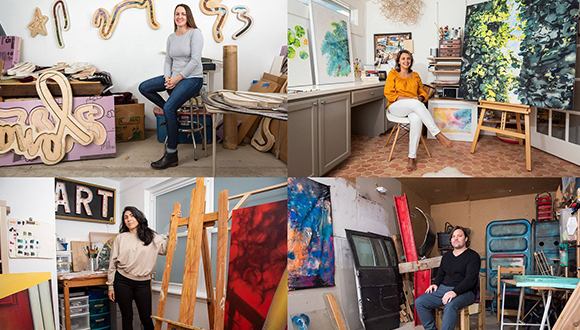
The 2020 Carter Community Artists. From top left: Kalee Appleton, Brenda Ciardiello, Michelle Cortez Gonzales, and Kasey Short.
While Arts Fort Worth provides exhibition space, professional development opportunities, and runs an artist residency program, one hole in the local art scene is affordable studio spaces. In recent years, perhaps due to the influx of development, longtime artist studio spaces like Lancaster Lofts have closed and are being redeveloped as residential spaces. This is something that the newly established nonprofit Easyside is working to address. The organization recently moved into a space on the east side of Fort Worth, and has finished building out seven studio spaces for local artists, some of which will be for three of its founding board members. Along with providing affordable space, the organization will have a micro-gallery, a workshop, and plans to host programs like farmers markets to address food apartheid in the area.
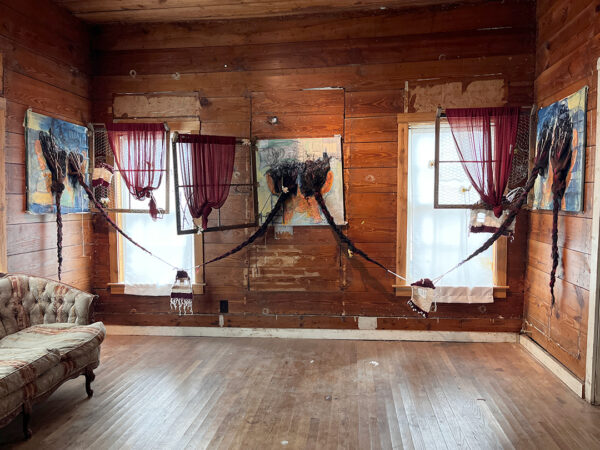
Deyjah Stewart, “Untitled (Braids),” 2022, synthetic hair, acrylic, thread, yarn, wood, chicken wire, weavings, artificial daisies, and twigs on hand-sewn muslin and canvas scraps. On view at Kinfolk House, 2023.
This social practice work of offering art programming and addressing community needs is also at the heart of Kinfolk House (where I serve as Executive Director), which opened in 2022. Founded by Sedrick and Letitia Huckaby, Kinfolk House is just a mile away from Easyside, in the former residential home of Sedrick’s maternal grandmother. Unlike Easyside, Kinfolk does not focus on studio spaces, but instead offers a platform for historically marginalized artists, such as artists of color, women artists, and artists who identify as LGBTQ+. The two organizations do share a desire to support the local community. Kinfolk does this through traditional arts programming like artist talks and workshops, and also through nontraditional programs like community cookouts, poetry readings, and movie nights.
Another newcomer to the scene is The Pool, an art venue managed by Near Southside, Inc., which opened last year in a 2,400-square-foot space on the ground floor of an apartment building. The organization is a partnership between the building owners, Saigebrook Development and O-SDA Industries, and Near Southside, Inc. While The Pool’s main focus is hosting art exhibitions, selected through a proposal process, it has also been the site of community gatherings and educational programming for artists in partnership with Arts Fort Worth. In many ways, the development of the space is an offshoot of Near Southside’s long-running Arts Goggle festival, which showcases local artists, musicians, and performers.
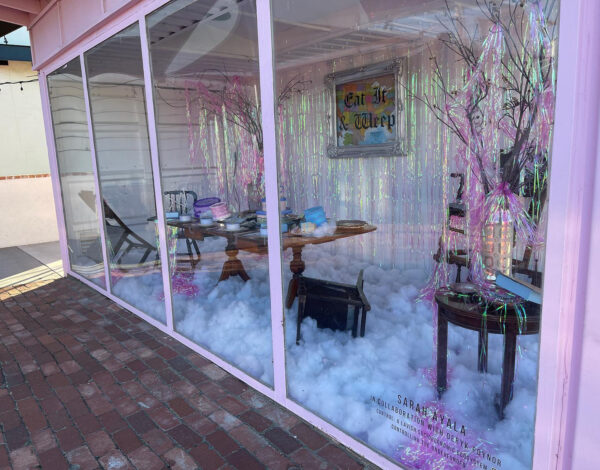
Sarah Ayala in collaboration with Deryk Poynor, “Cuntrol: A Lavish Socioeconomic Ecosystem Controlling the Underfunded.” 2021, on view at one of Art Tooth’s pop-up shows. Image: Art Tooth
Just a few days ago, Art Tooth, a nonprofit arts organization formed in 2016 as the result of a merger between Bobby on Drums and The Exhibitionists, announced that, like Easyside, it is also working to address the need for studio spaces. Though plans have not been finalized, Art Tooth is working to develop a space in Fort Worth’s South Side that could house up to ten artists by the fall. This new space would also become the office headquarters of Art Tooth, which has been traditionally a more grassroots, pop-up type of organization producing exhibitions in venues around the city. Executive Director Shasta Haubrich told me that the organization will still host pop-up shows in various locations, but that seven years into its run, Art Tooth continues to hear from artists that the biggest issue they face is affordable studio space.
Where We Go from Here
As Fort Worth continues to grow, the arts scene is expanding to meet the needs of artists, which is a complicated issue since the city itself doesn’t offer funding for individuals. Perhaps in part to help fill this gap, it has been exciting over the last few years to see new spaces and organizations form with the goal of supporting artists and communities in a multitude of ways. As the price of housing rises, it affects the affordability of all real estate, including galleries and artist studios. As such, is important to remember that with a growing city, comes gentrification. Areas of Fort Worth that have been historically Black and brown neighborhoods, like the Southside and East Side, are seeing an influx of development, which brings the real possibility of displacement.
Over the last two decades, the city’s Near Southside has seen this type of shift, and perhaps a little too late the community organization Hemphill No Se Vende has emerged to attempt to protect the area from continued gentrification. The opening of spaces like Kinfolk House and Easyside signals that artists are aware that they are often the first wave in gentrification; these organizations’ responsiveness to specific local needs, in addition to their arts programing, shows that they are trying to be mindful of their effect on the communities in which they are situated.
With new spaces like Love Texas Art and Dang Good Candy closing quickly after opening and the future of even longstanding organizations like Arts Fort Worth still undecided, the art scene is still in a transitional state. We still have to see if the city can maintain its current five major galleries. Perhaps the biggest question now is how the newly opened J. Peeler Howell might affect the long-established William Campbell Gallery. With some artists leaving WCG to go with Howell, I am not certain that the gallery can sustain two physical locations.
The RFP for redeveloping Arts Fort Worth’s building is out in the world, and submissions are due to the city by September 14. Public presentations of proposals by finalists are expected to occur just one month later, on October 11, and the selected firm will be approved by City Council in January 2024. While there is still a lot of fear brewing among local artists about what will become of the space, I feel confident that it will maintain its overall function in the art scene as a venue for visual and performing arts. Though, even if the organization were to lose part of the presentation spaces it currently holds, I am hopeful that could lead to creative solutions to bring the organization out of the cultural district and into other parts of the city, to communities who may find it difficult to visit Arts Fort Worth’s current location.
One of the biggest questions that lays ahead is: Is there enough funding for emerging nonprofits in Fort Worth? With Arts Fort Worth’s grants limited to organizations that have two years of programming already under their belts, and with a handful of new places popping up, can the organization’s grants (which are city-funded) support the development of new spaces? Or, more pointedly, is there enough city money to go around? Currently, both Art Tooth and Easyside have fundraisers going to raise money in support of their affordable artist studios.
Both organizations are working toward this very important goal. Art Tooth, which has been around for seven years, can apply for city grants, but the new Easyside is not yet eligible. Beyond city funding, is there enough individual and corporate funding to support two sets of artist studios? Even with the recent Texas Cultural Trust report highlighting the economic impact of the arts, it seems that the City of Fort Worth is hesitant to fund the arts in a substantial way, as other large cities across the state do. This leaves small and midsized nonprofits competing for state and national funding, as well as local donations.
Fort Worth has a long history of artists communities and collectives, including the Fort Worth Circle artists of the 1940s and 1950s; the Blagg brothers and artists of Studio 111, which emerged in the 1980s; F6 Gallery Collective in the early 2000s; Homecoming Committee!, founded in 2011; and Fort Worth Art Collective, Bobby on Drums, the Exhibitionists, and Art Hunger in the mid 2010s. Many of the artists establishing these organizations have come through art programs at local colleges and universities. From Tarrant County College’s well-established photography department at its northeast campus and its strong art program at its south campus to the BFA and MFA programs at Fort Worth-based Texas Christian University and the nearby University of Texas at Arlington, University of Texas at Dallas, and University of North Texas, there is no shortage of educational institutions churning out new artists.
It is not surprising that the artists (who were a part of these collectives and have emerged from North Texas colleges and universities) who have stayed in Fort Worth are looking for more sustainable ways to support themselves and their peers. As the city’s population booms, the next few years will be telling — the art scene is primed to grow, but the sustainability of that growth, and how individual artists will either be retained or pushed out by it — has yet to be seen.


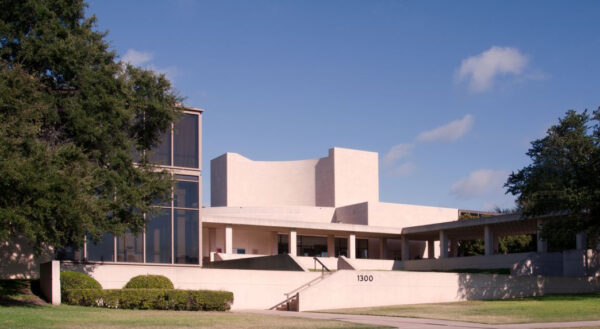

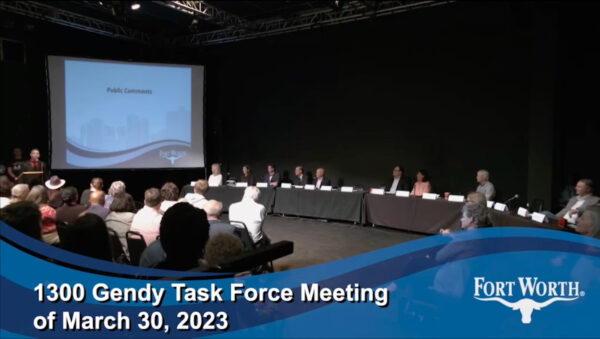
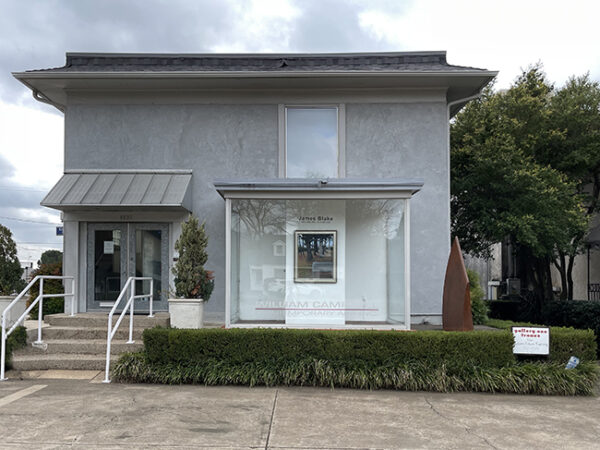
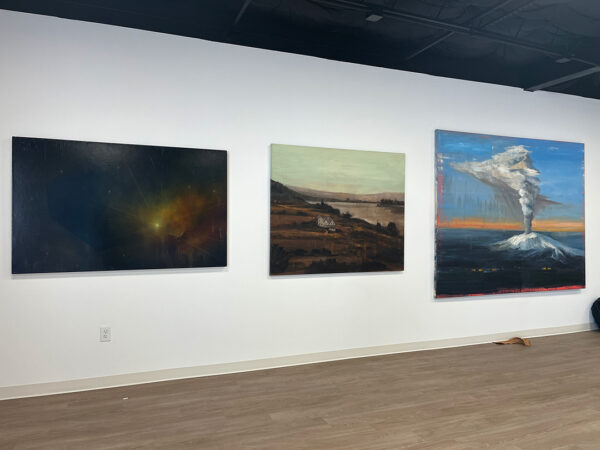
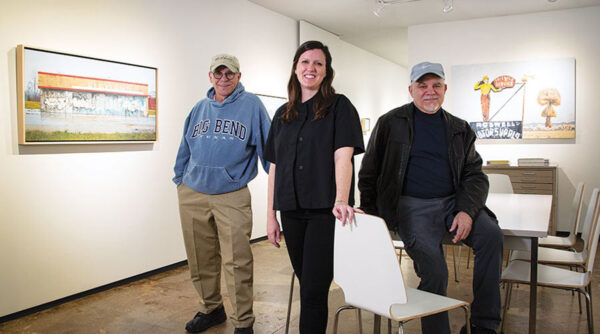
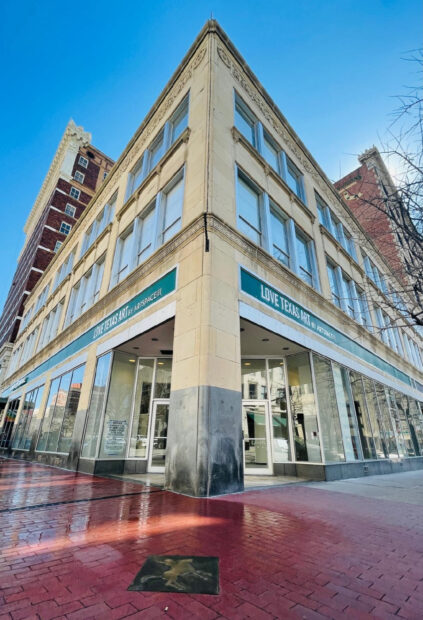
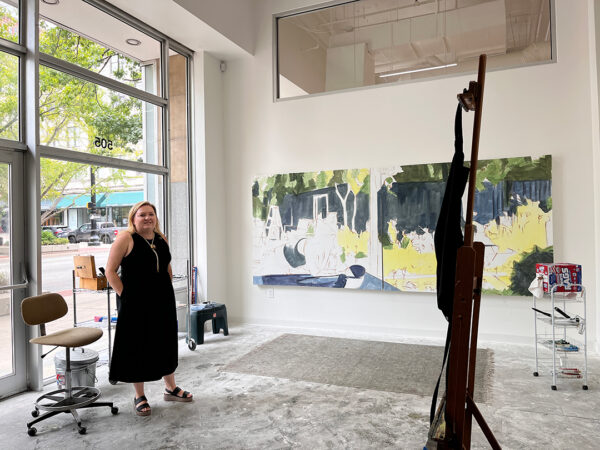
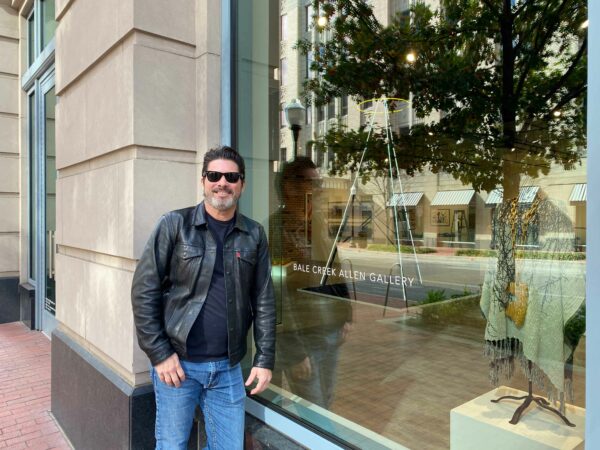
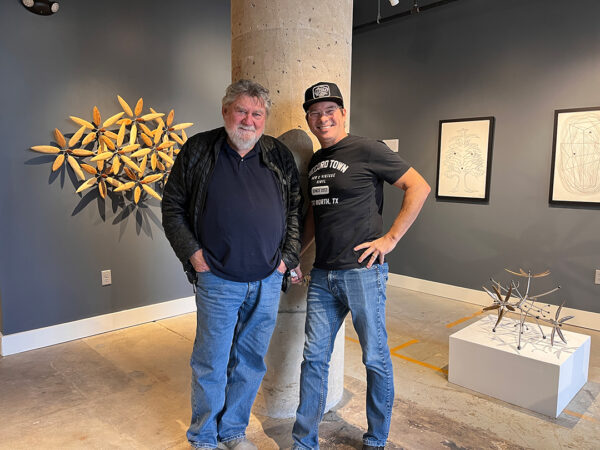
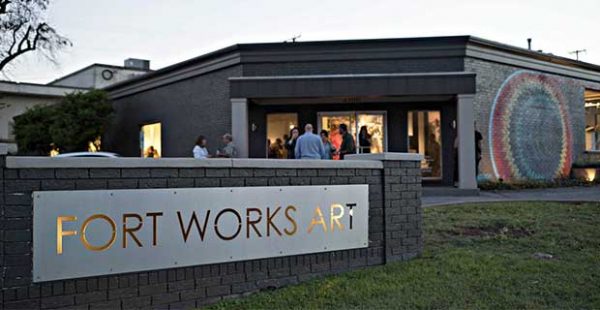
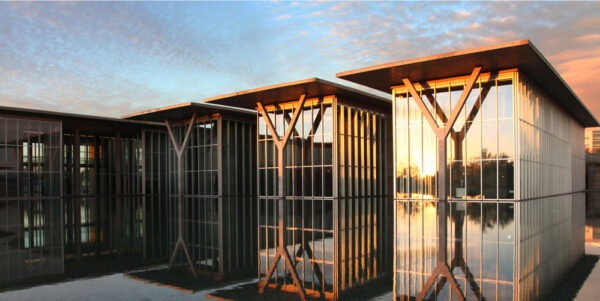

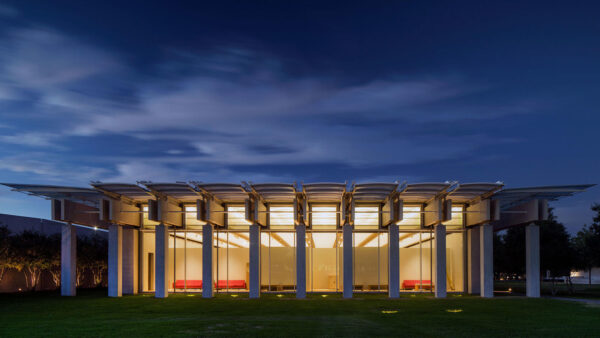
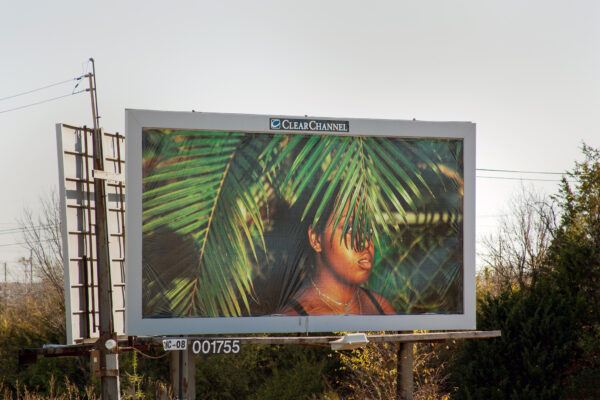

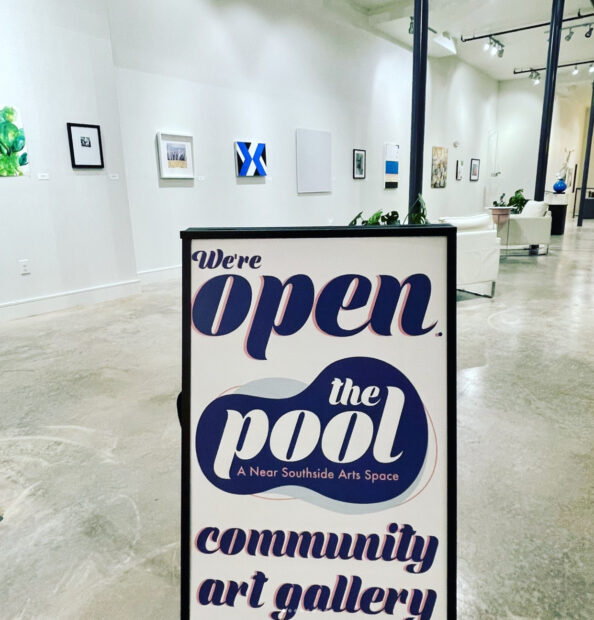
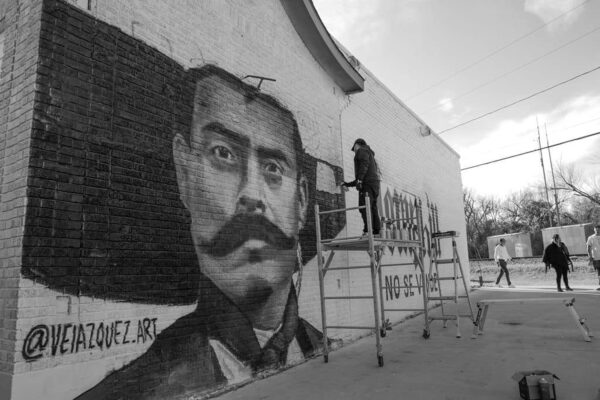

4 comments
Excellent! The overview and historical content that I didn’t know that I needed, but I did! Thank you.
Great article!!! I learned so much. This article gave an amazing comprehensive report on Fort Worth’s Art scene. I do see that this is a crucial time for the Future of the Arts in Fort Worth. With Fort Worth growing and the Art scene primed for huge expansions, this city needs Vision and Commitment to establish funding, space, and Cultural awareness of the need for a strong Local Arts Presence. Thank you for bringing all of this information together. We need Visionaries and Advocates for the Arts to help establish the idea of the importance of the Arts in Fort Worth!
This is truly an incredible treatise on the Fort Worth art scene. The historical perspective is particularly helpful for contextualizing current events in this space. Thank you so much for this labor!
Great, comprehensive view of where we stand. I was reminded of happy memories — friends, art, and venues — and glad to learn of new spaces and players. Thank you, Jessica!